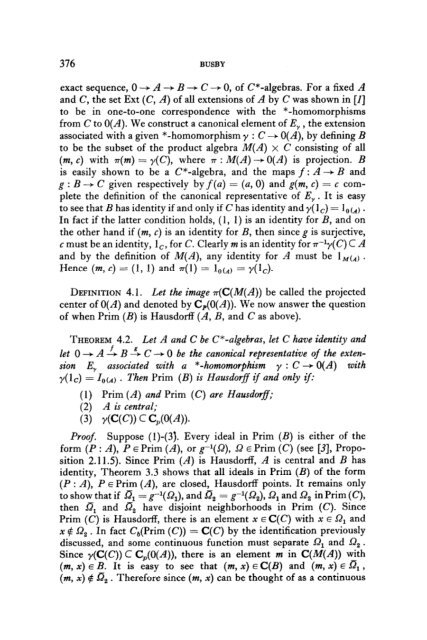On the Characters and the Plancherel Formula of Nilpotent Groups ...
On the Characters and the Plancherel Formula of Nilpotent Groups ...
On the Characters and the Plancherel Formula of Nilpotent Groups ...
You also want an ePaper? Increase the reach of your titles
YUMPU automatically turns print PDFs into web optimized ePapers that Google loves.
376 BUSBY<br />
exact sequence, 0 -+ A -+ B ---t C -+ 0, <strong>of</strong> C*-algebras. For a fixed A<br />
<strong>and</strong> C, <strong>the</strong> set Ext (C, A) <strong>of</strong> all extensions <strong>of</strong> A by C was shown in [Z]<br />
to be in one-to-one correspondence with <strong>the</strong> *-homomorphisms<br />
from C to O(A). We construct a canonical element <strong>of</strong> E, , <strong>the</strong> extension<br />
associated with a given *-homomorphism y : C ---f O(A), by defining B<br />
to be <strong>the</strong> subset <strong>of</strong> <strong>the</strong> product algebra M(A) x C consisting <strong>of</strong> all<br />
(m, c) with r(m) = y(C), where r : M(A) -+ O(A) is projection. B<br />
is easily shown to be a C*-algebra, <strong>and</strong> <strong>the</strong> maps f : A -+ B <strong>and</strong><br />
g : B --t C given respectively by f (u) = (a, 0) <strong>and</strong> g(m, c) = c com-<br />
plete <strong>the</strong> definition <strong>of</strong> <strong>the</strong> canonical representative <strong>of</strong> E, . It is easy<br />
to see that B has identity if <strong>and</strong> only if C has identity <strong>and</strong> y( 1 c) = 1, tR) .<br />
In fact if <strong>the</strong> latter condition holds, (1, 1) is an identity for B, <strong>and</strong> on<br />
<strong>the</strong> o<strong>the</strong>r h<strong>and</strong> if (m, c) is an identity for B, <strong>the</strong>n since g is surjective,<br />
c must be an identity, 1 c, for C. Clearly m is an identity for rr-ly( C) C A<br />
<strong>and</strong> by <strong>the</strong> definition <strong>of</strong> M(A), any identity for A must be lMcA) .<br />
Hence (m, c) = (1, 1) <strong>and</strong> ~(1) = lata) = y( 1,).<br />
DEFINITION 4.1. Let <strong>the</strong> image r(C(M(A)) be called <strong>the</strong> projected<br />
center <strong>of</strong> O(A) <strong>and</strong> denoted by C,(O(A)). We now answer <strong>the</strong> question<br />
<strong>of</strong> when Prim (B) is Hausdorff (A, B, <strong>and</strong> C as above).<br />
THEOREM 4.2. Let A <strong>and</strong> C be C*-algebras, let C have identity <strong>and</strong><br />
let 0 -+ A L B -% C -+ 0 be <strong>the</strong> canonical representative <strong>of</strong> <strong>the</strong> exten-<br />
sion E,, associated with a *-homomorphism y : C --f O(A) with<br />
y( 1 c) = l,,ta) . Then Prim (B) is HausdorJff if <strong>and</strong> only if:<br />
(1) Prim (A) <strong>and</strong> Prim (C) are Hausdorff;<br />
(2) A is central;<br />
(3) Y(W)) C C,(W)).<br />
Pro<strong>of</strong>. Suppose (l)-(3). E ver 1 ea in Prim (B) is ei<strong>the</strong>r <strong>of</strong> <strong>the</strong><br />
y ‘d 1<br />
form (P : A), P E Prim (A), or g-l(Q), 9 E Prim (C) (see [3], Propo-<br />
sition 2.11.5). Since Prim (A) is HausdorB, A is central <strong>and</strong> B has<br />
identity, Theorem 3.3 shows that all ideals in Prim (B) <strong>of</strong> <strong>the</strong> form<br />
(P : A), P E Prim (A), are closed, Hausdorf? points. It remains only<br />
to show that if or = g-‘( Q,), <strong>and</strong> Dz = g-I( a,), Q, <strong>and</strong> Q, in Prim (C),<br />
<strong>the</strong>n Dr <strong>and</strong> az have disjoint neighborhoods in Prim (C). Since<br />
Prim (C) is Hausdorf?, <strong>the</strong>re is an element x E C(C) with x E Qr <strong>and</strong><br />
x $ Q, . In fact C,(Prim (C)) = C(C) by <strong>the</strong> identification previously<br />
discussed, <strong>and</strong> some continuous function must separate 52, <strong>and</strong> Q, .<br />
Since y(C(C)) C C&O(A)), <strong>the</strong>re is an element m in C(M(A)) with<br />
(m, X) E B. It is easy to see that (m, x) E C(B) <strong>and</strong> (m, x) E or,<br />
(m, x) $ D, . Therefore since (m, x) can be thought <strong>of</strong> as a continuous

















